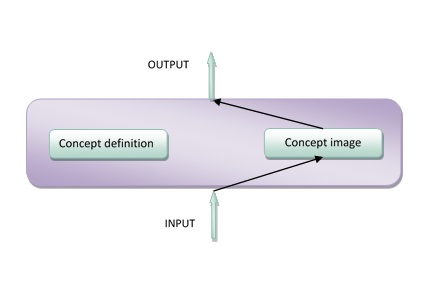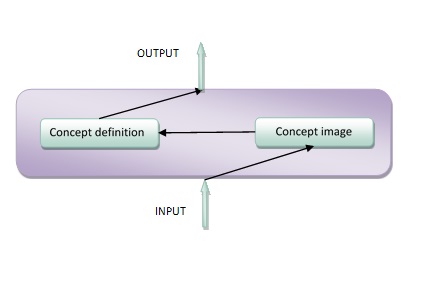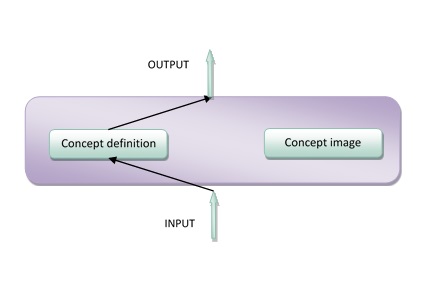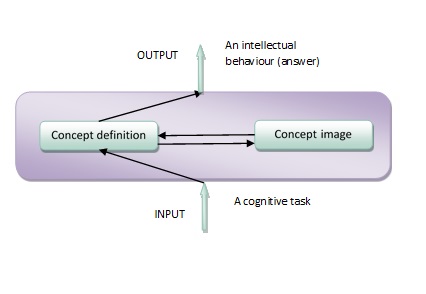This is the second of two posts introducing some of the background ideas to consider when looking at the transition to university mathematics. The first post focused on the transition and the specific problems and issues frequently noted for mathematics. This post discusses some aspects/models of advanced mathematics at university which are particularly relevant to these issues.
Studying Mathematics at University
I was repeatedly told that university maths was very different from 'A' Level maths – I would have appreciated knowing which branch of 'A' Level maths it was most similar to. (Unnamed student in Cornelius, 1972, p. 3)
What is different about mathematics at university?
Symbols are one of the most recognisable aspects of advanced mathematics to even non-mathematicians. Like most languages, notation comes rules and conventions, which the students must learn to navigate, and may differ from that used previously, even for the same subject (Lewis & White, 2002). Notation can also become far more ambiguous than might be expected from such a rigorous subject. Gray and Tall (1994) give the example of the expression “3+4” which represents both the process of addition and also the result of that process. They name the successful mental structure that develops in dealing with this duality a “procept” [1]. At undergraduate level, the notation for a limit is an example of a similar duality.
APOS theory (Action, Process, Object, Schema) provides a framework around which one can categorise the stages of some mathematics learning and links to the issues encountered with notation. The framework follows a path of development from simple procedural mechanistic actions, through an understanding and manipulation of that action (e.g. inverting it), to the ability to act on the action itself, with the final schema representing an overview and understanding of the underlying unifying principles (see Dubinsky & Mcdonald, 2001).
Summary of APOS theory:
| Action | able to produce output from input |
| Process | view whole process, linking processes e.g. able to invert |
| Object | encapsulation, acting on an object (though without this, still possible to manipulated symbols). |
| Schema | A,P and O etc. all linked by some general principles that can be brought to bare on a problem.
|
An important structural difference in teaching methods at university is the change in the ratio of the quantity of knowledge to be learnt to the available time for its acquisition (Robert and Schwarzenberger, 1991).The student may have little time to understand the new concept before being asked to use it functionally. In this context, a student may be introduced to a new action and quickly expected to manipulate it. The very next lecture, the course may have suddenly moved on (from the student’s point of view) to use the notation that previously represented the process, as an object to act on. Notation often follows a process from elaborate structure explicitly reflecting mental actions to tacitly reflecting an entity. For example the “matrix of the linear transformation T relative to the pair of ordered bases μ and ν” (Harel & Kaput, 1991):
[T]μ→ν becomes [T]μν or simply T
Lecturers can often use and manipulate notation that represents their own position of comfort with higher encapsulations whilst the student has only just been introduced to the action.
[1] An amalgam of process and concept.
Concept Definition and Concept Image
An important part of investigations aimed at educational improvement is the study of how students learn. The sub-field of the psychology of advanced mathematics has produced a number of insights over the last few decades despite natural problems that
...the subject involves two disciplines, psychology and mathematics, and would require, in order to be treated adequately, that one be both a psychologist and a mathematician. (Hadamard, 1949, p. 1)
A working group of the International Group for the Psychology of Mathematics (PME) on Advanced Mathmatical Thinking (AMT), founded in 1985, produced a book summarising the results of this research (Tall, 1991a). More recently, a short booklet has been produced for university mathematics lecturers detailing the “Ideas from Mathematics Education” (Alcock & Simpson, 2009). One of the key ideas from such research is Tall and Vinner’s distinction between what they call a students’ concept image and the concept definition. The latter is the formal definition given in lectures, whereas the former “consists of all the cognitive structure in the individual's mind that is associated with the concept” (Tall & Vinner, 1981, p. 151). The thought process of a student may use one or both of these, as represented in the figures below (all based on (Vinner, 1991)).
In many cases new knowledge is added to an existing set, producing an “expansion” (Skemp, 1987). Alternative situations may occur when a student’s concept image may be non-standard or insufficient for the task, leading to misconceptions and mistakes, or alternatively may be incompatible with new information. The latter situation can lead to “cognitive conflict” (Tall, 1977) producing alternative educational outcomes: the new information could be ignored and treated as an exception, both conceptions may be simultaneously held (“cognitive dissonance”) and used in different circumstances, and finally the image may be “reconstructed” to accommodate the new information (Vinner, 1991). Cognitive conflict can be both difficult and at times necessary (in order to produce the reconstructed knowledge).
For the lecturer, understanding these processes may be difficult in any subject, but is particularly acute in mathematics:
One finally masters an activity so perfectly that the question of how and why [students don't understand] is not asked anymore, cannot be asked anymore and is not even understood anymore as a meaningful and relevant question (Freudenthal, cited in Eisenberg, 1991, p. 145)
The logical structure of the lecturers’ image may be inappropriate or unhelpful for the student (Tall, 1991b). It will be the result of mathematical “vertical” growth of knowledge, the result of a linear acquisition based on prerequisites, and “horizontal” growth, the ability to translate and connect across different mathematical areas and representations (Harel & Kaput, 1991). The student lacks both the required build up of knowledge, but also the overview to see the connections between different areas.




Formal mathematics
In terms of subject content, Nardi (1996) summarises the change as one from informal to formal mathematics. This change is epitomised by aspects of advanced mathematics that are fundamental at university level but new for the students: the importance of proof and definition.
Formal definitions play a key part in mathematics at university and can be an area in which students struggle. As with the examples above of notation and objects, definitions are based around the current conceptualisation and students are often asked to use these before understanding has been developed (Harel & Kaput, 1991). Furthermore, students typically come across mathematical concepts in early life via experience and experimentation and the definition of a term that they give is often similar to the type one finds in everyday life in a dictionary i.e. reporting current usage. Formal mathematical definitions by contrast are consciously created to effectively create usage based on a strict description. Edwards and Ward (2004) describe this division using the terms from philosophy “lexical” versus “stipulative” definitions. The importance of the difference is not always immediately grasped by undergraduates, leading to misconceptions and inappropriate use (Alcock & Simpson, 2009; Edwards and Ward, 2004) and thus definition “represents...the conflict between the structure of mathematics, as conceived by professional mathematicians, and the cognitive process of concept acquisition” (Vinner, 1991). Words such as ‘limit’ have additional everyday meanings, such as an impassable barrier, which may differ from the mathematical limit behaviour (Cornu, 1991) and such prior conceptions do not simply disappear at the beginning of formal study (Tall & Schwarzenberger, 1978). Unfortunately such inaccurate descriptions are not limited to words which have everyday meanings, as Edwards and Ward (2004) found using non-loaded words such as ‘coset’.
Difficulties with key concepts for undergraduates is not surprising given the fact that the historical development of concepts is not always smooth with a number of epistemological obstacles along the way and many contrasting opinions by the great mathematicians of antiquity (see e.g. Cornu, 1991, on the development of limits). The sociological practice of mathematics is not the same as the finished (or current) product, an issue which is prevalent in the other major topic of difference for advanced mathematics: proof.
Proof
I would be grateful if anyone who has understood this demonstration would explain it to me
- Deligne, a Fields Medallist, writing after one of his own proofs (cited in Alibert & Thomas, 1991, p.220)
Proof is now largely absent from the secondary curriculum in the UK, but is central to formal mathematics. This is one of the major differences that an undergraduate student will encounter in terms of ‘doing’ mathematics: the shift from mathematics as calculating answers to the need to prove conjectures and theorems. Students often struggle with understanding the process of constructing proofs (Nardi & Iannone, 2006). The common refrain “I don’t know where to start” will be familiar to those involved (either as students or teachers) in advanced mathematics and is one of the main cognitive difficulties for students learning formal proof (Moore, 1994). Part of the problem is that the epistemology of mathematical discovery is not well represented by, and often considerably different to, the usual presentation of proof (Alibert & Thomas, 1991). This presentation is the final product taking the direct route of logical argument that the researcher ‘would’ have taken, in hindsight. Teaching often ‘starts’ with the end product, the finished proof (Tall, 1991b), which may convince the students of its correctness, but may neither aid their understanding nor their ability to conduct such activity themselves.
One of the difficulties in finding a correct logical path is choice and the need for creativity. New undergraduates, like the general public, are more familiar with mathematics as calculation and may be surprised by the creativity and consequent subjectivity in terms of the process of ‘doing’ mathematics. This creativity is
...the ability to solve problems and/or to develop thinking in structures, taking account of the peculiar logico-deductive nature of the discipline , and of the fitness of the generated concepts to integrate into the core of what is important in mathematics. (Ervynck, 1991).
The creativity is lost in the formal presentation of proof, which strips out the wrong turnings and the choices present at each stage [2] making it difficult for students to gain the strategic knowledge necessary to develop the skills to construct proof (Weber, 2001). Hadamard (1949) was one of the first to investigate the psychology of creating new mathematics, and the books of both Polya (2004) and Mason et. al. (1982) provide further insight to the approaches professional mathematicians use.
[2] Galois, an intuitive creative mathematician, is quoted as saying that he “hated reading treatise on algebra, because he failed to find in them the characteristics of the inventors” (Hadamard, 1949, p.11).
The post above has briefly introduced some key aspects of advanced mathematical thinking and ideas from mathematics education literature. The first reference below (Alcock & Simpson (2009)) can be found online and was written as a guide for lecturers introducing many of these theoretical ideas. This and other work from the old MSOR subject centre provide a number of resources and reports to explore if interested, including practical books/guides on teaching mathematics. Tall (1991a), Advanced mathematical thinking, is a good book for more depth, created as a summary of the ideas and research at the time.
References
Alcock, L., & Simpson, A. (2009). Ideas from Mathematics Education. Maths, Stats & OR Network
Alibert, D., & Thomas, M. (1991). Research on Mathematical Proof. In D. Tall (Ed.), Advanced Mathematical Thinking, Mathematics education library, v. 11 (pp. 215-230). Dordrecht; Boston: Kluwer Academic Publishers.
Cornelius, M. L. (1972). The Transition from School to University Mathematics. The Mathematical Gazette, 56(397), 207-218.
Cornu, B. (1991). Limits. In D. Tall (Ed.), Advanced Mathematical Thinking, Mathematics education library, v. 11 (pp. 153-166). Dordrecht; Boston: Kluwer Academic Publishers.
Dubinsky, E. & Mcdonald, M., 2001. APOS: A Constructivist Theory of Learning in Undergraduate Mathematics Education Research. In The Teaching and Learning of Mathematics at University Level. pp. 275-282.
Edwards, B. S., & Ward, M. B. (2004). Surprises from mathematics education research: Student (mis)use of mathematical definition. American Mathematical Monthly, 111, 411-424.
Eisenberg, T. (1991). Functions and Associated Learning Difficulties. In D. Tall (Ed.), Advanced Mathematical Thinking, Mathematics education library, v. 11 (pp. 140-152). Dordrecht; Boston: Kluwer Academic Publishers.
Ervynck, G. (1991). Mathematical Creativity. In D. Tall (Ed.), Advanced Mathematical Thinking, Mathematics education library, v. 11 (pp. 42-53). Dordrecht; Boston: Kluwer Academic Publishers.
Grey, E., & Tall, D. (1994). Duality, Ambiguity and Flexibility: A Proceptual View of Simple Arithmetic. Journal for Research in Mathematics Education, 26(2), 115-141.
Hadamard, J. (1949). An essay on the psychology of invention in the mathematical field. (2nd ed.). Princeton University Press.
Harel, G., & Kaput, J. (1991). The Role of Conceptual Entities and their Symbols in Building Advanced Mathematical Concepts. In D. Tall (Ed.), Advanced Mathematical Thinking, Mathematics education library, v. 11 (pp. 82-94). Dordrecht; Boston: Kluwer Academic Publishers.
Lewis, H., & White, J. (2002). Teaching across the A level - university transition. MSOR Connections, 2(4), 14-18.
Mason, J., Burton, L., & Stacey, K. (1982). Thinking Mathematically. Addison-Wesley.
Moore, R. C. (1994). Making the Transition to Formal Proof. Educational Studies in Mathematics, 27(3), 249-266.
Nardi, E. (1996). The Novice Mathematician's Encounter With Mathematical Abstraction. University of Oxford. Retrieved May 12, 2012, from http://www.uea.ac.uk/~m011/thesis/welcome.htm
Nardi, E., & Iannone, P. (2006). How to prove it: a brief guide for teaching proof to Year 1 mathematics undergraduates. Commissioned by the Higher Education Academy (Mathematics, Statistics and Operational Research branch).
Polya, G. (2004). How to Solve It: A New Aspect of Mathematical Method. Princeton University Press.
Robert, A., & Schwarzenberger, R. (1991). Research in Teaching and Learning Mathematics at an Advanced Level. In D. Tall (Ed.), Advanced Mathematical Thinking, Mathematics education library, v. 11 (pp. 127-139). Dordrecht; Boston: Kluwer Academic Publishers.
Tall, D. (1991a). Advanced mathematical thinking. Mathematics education library, v. 11. Dordrecht; Boston: Kluwer Academic Publishers.
Tall, D. (1991b). The Psychology of Advanced Mathematical Thinking. In D. Tall (Ed.), Advanced Mathematical Thinking, Mathematics education library, v. 11 (pp. 3-21). Dordrecht; Boston: Kluwer Academic Publishers.
Tall, D., & Vinner, S. (1981). Concept image and concept definition in mathematics with particular reference to limits and continuity. Educational Studies in Mathematics, 12(2), 151-169.
Vinner, S. (1991). The Role of Definitions in the Teaching and Learning of Mathematics. In D. Tall (Ed.), Advanced Mathematical Thinking, Mathematics education library, v. 11 (pp. 65-81). Dordrecht; Boston: Kluwer Academic Publishers.
Weber, K. (2001). Student difficulty in constructing proofs: The need for strategic knowledge. Educational Studies in Mathematics, 48(1), 101-119.